Cell Signaling Market Size
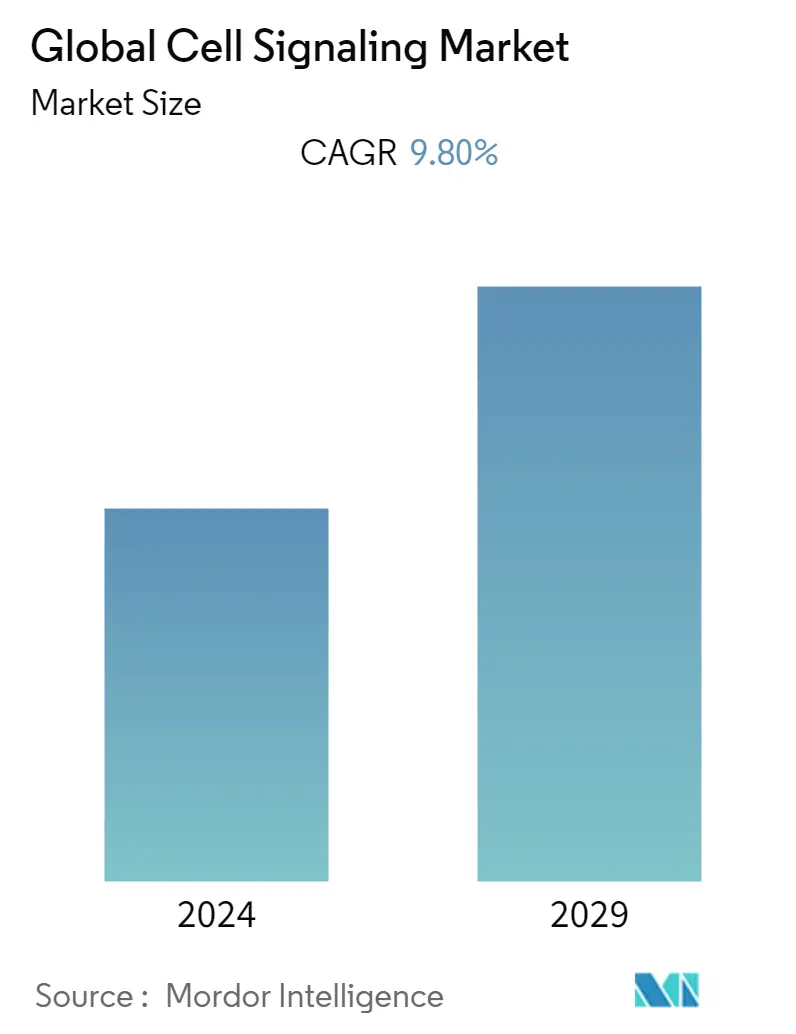
| Study Period | 2019 - 2029 |
| Base Year For Estimation | 2023 |
| CAGR | 9.80 % |
| Fastest Growing Market | Asia-Pacific |
| Largest Market | North America |
| Market Concentration | Low |
Major Players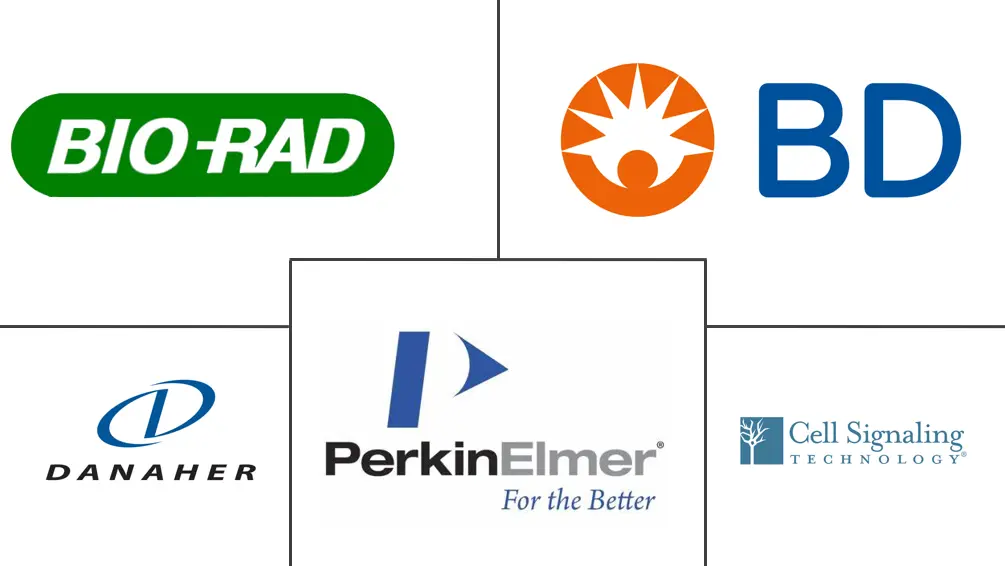
*Disclaimer: Major Players sorted in no particular order |
Cell Signaling Market Analysis
The cell signaling market is expected to register a CAGR of 9.8% over the forecast period
The COVID-19 pandemic had a profound impact on the market studied. A study published in the journal News Medical, "SARS-CoV-2 spike protein triggers cell signaling pathways in lung vascular cells" in October 2020 stated that vascular cells in the lung tissue begin to secrete signaling growth factors when exposed to just the spike protein of severe acute respiratory syndrome coronavirus without the rest of the viral components. As this signaling mechanism is potentially linked to worse outcomes in this situation, these findings could indicate new targets for the development of therapeutic agents. Thus, the high utility of cell signaling models for research about COVID-19 and respiratory diseases has offered significant growth opportunities to the market.
The significant factors for the growth of the cell signaling market include the rising incidence of chronic diseases, increased funding for cell-based research, and technological advancements in cell-based research instruments. For instance, in April 2022, as per the national library of medicine 1,898,160 new cancer cases and 608,570 cancer deaths are projected to occur in the United States 2021. There is rising funding for cell-based research across the world. For instance, according to the data available on the portal for the National Institutes of Health (NIH), an estimated USD 45 billion was granted for stem cell research in the fiscal year 2021. Similar in March 2020, increments in funding grants were observed for research of embryonic stem cells and induced pluripotent stem cells. Similar positive trends in the increment of fund grants have been observed in the European Union for cell-based research. Consequently, the increasing participation of the government in the development of cell-based research, in the form of incremental funding, is expected to drive the growth of the market studied. Other factors contributing to the growth of the market studied include the increasing incidence of chronic diseases and technological advancements in cell-based research instruments.
However, the high cost of cell signaling systems and ethical issues related to embryonic stem cell signaling research are likely to hinder the market growth.
Cell Signaling Market Trends
This section covers the major market trends shaping the Cell Signaling Market according to our research experts:
The AKT Signaling Pathway Segment is Expected to Register Good Growth Over the Forecast Period
The AKT signaling pathway, also known as the survival pathway, is responsible for the increased proliferation, loss of apoptosis signaling, and cell growth. The AKT signaling pathway is the most commonly dysregulated pathway in the most prevalent forms of cancer. A number of drugs have been designed based on the rationale that inhibition of AKT pathway, could help in achieving therapeutic results. A number of drugs based on AKT signaling are currently in various stages of clinical trials.
In the treatment of advanced-stage COVID-19 patients, AKT is found as a potential therapeutic target. Its inhibition will potentially suppress the cytokine storm, fibroproliferation, pathological inflammation, and platelet activation associated with COVID-19. It also promotes resolution and prevents scarring in injured lungs. As per the study published "AKT a viable option to treat advanced-stage COVID-19 patients" in 2020, pharmacological inhibition of AKT has also been reported to inhibit angiotensin-converting enzyme 2 (ACE2) expression, a receptor for the virus entry into the lung cells, and targeting AKT for COVID-19 looks like a viable option.
Over the forecast period, this market is expected to grow, as commercial diagnostic tests are expected to emerge based on down-regulation of the AKT pathway.
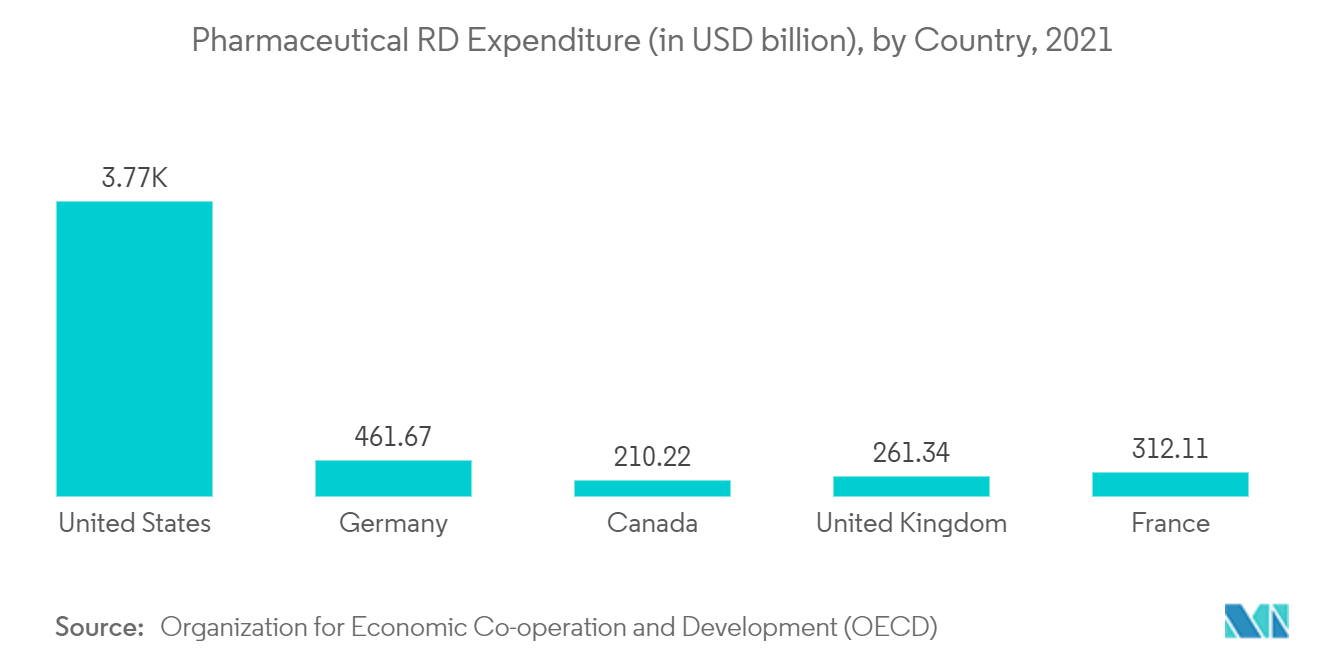
North America is Expected to Dominate the Market Over the Forecast Period
North America holds a significant share of the cell signaling market and is expected to show a similar trend over the forecast period, without significant fluctuations. The cell signaling market is expected to witness numerous growth opportunities during the pandemic, with cell signaling pathways being utilized as experimental virology platforms to study the immune responses and infectivity of SARS-CoV-2. Most of the major players have been involved in R&D activities regarding cell signaling pathways. The mortality in most COVID-19 patients is due to the presence of a cytokine storm, which is induced by the virus. The excessive production of these proinflammatory cytokines leads to acute respiratory distress syndrome aggravation and widespread tissue damage, which results in multi-organ failure and death. Thus, targeting cell signaling pathways such as cytokines during the management of COVID-19 may lead to the reduction of the mortality rate and improved outcomes. This is likely to have a positive impact on the market studied.
In the United States, for the fiscal year 2021, USD 575 million was granted by the federal government for the National Cancer Institute (NCI) budget for breast cancer research, USD 225 million for colorectal cancer research, and USD 250 million for leukemia. Additionally, the estimates available on the National Institute of Health Portal for stem cell-based research indicate a cumulative funding budget of more than USD 3 billion for research in various fields of stem cell applications. The need for cell signaling in cancer research plays a vital role in the progressive growth of the cell signaling market in the United States. The growing funding in cancer research and stem cell research are directly causing an increase in cell signaling research, particularly in the United States. The increasing trend of increment in research funding is expected to lead to the growth of the market studied in the United States.
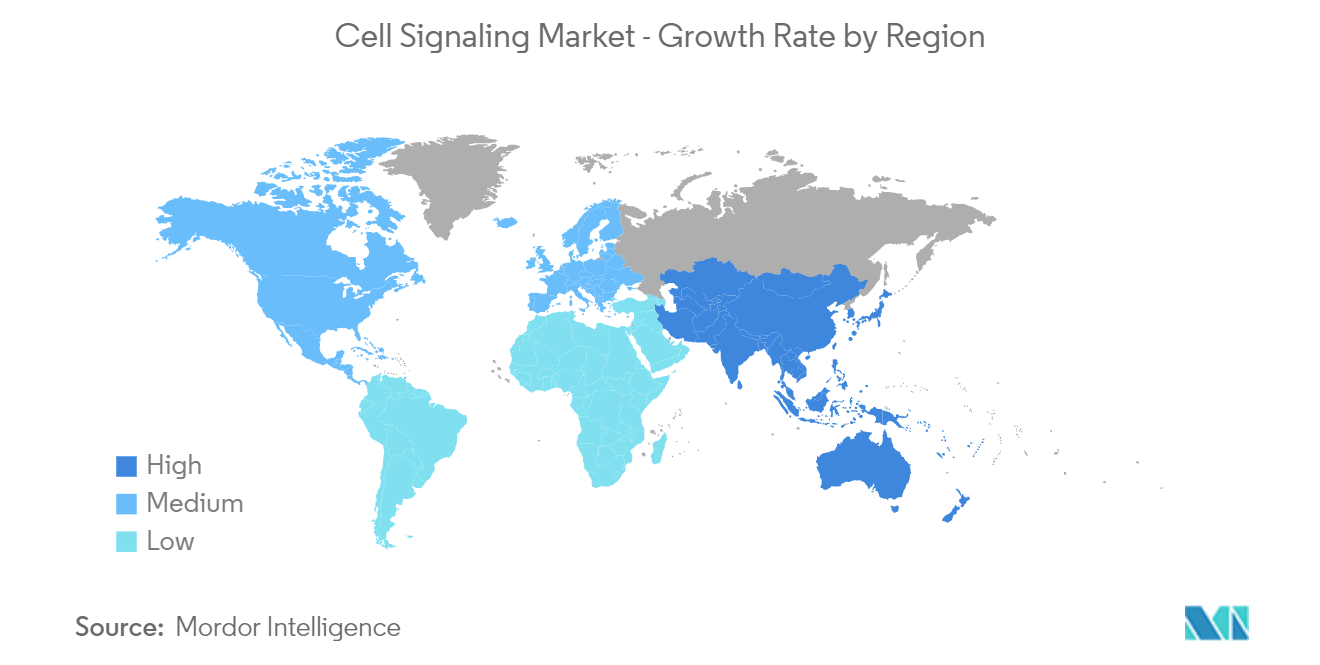
Cell Signaling Industry Overview
The market studied is a moderately consolidated market owing to the presence of small and large market players. Some of the market players are Danaher Corporation (Beckman Coulter Inc.), Becton, Dickinson and Company, Bio-Rad Laboratories Inc., Bio-Techne Corporation, Cell Signaling Technology Inc., Merck KGaA, PerkinElmer Inc., Promega Corporation, Qiagen NV, and Thermo Fischer Scientific Inc.
Cell Signaling Market Leaders
-
Bio-Rad Laboratories Inc.
-
Cell Signaling Technology Inc.
-
PerkinElmer Inc.
-
Becton, Dickinson and Company
-
Danaher Corporation (Beckman Coulter Inc.)
*Disclaimer: Major Players sorted in no particular order
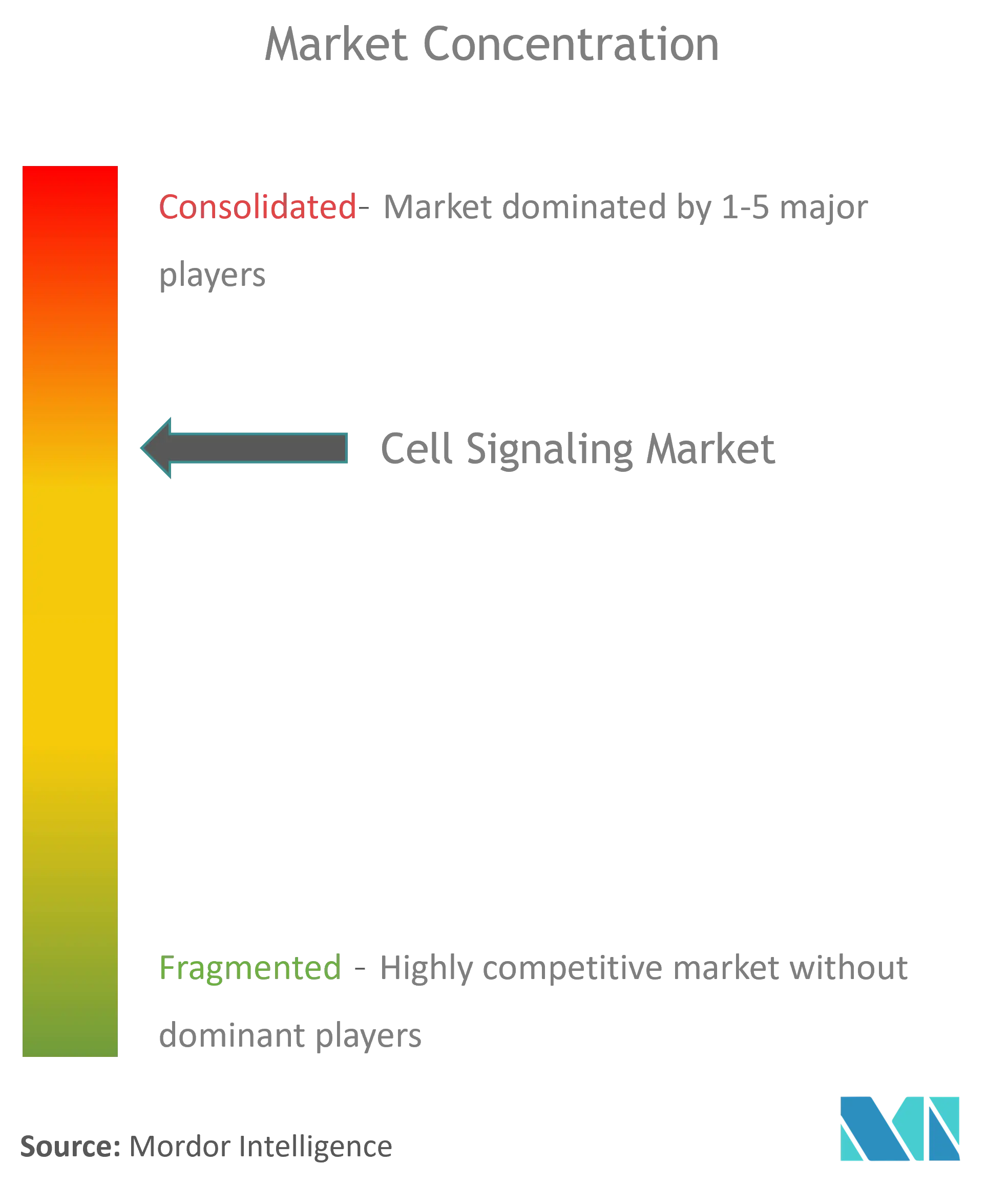
Cell Signaling Market News
- In June 2021, Thermo Fisher Scientific and the University of Sheffield teamed up to create enhanced end-to-end processes for the characterization and monitoring of complex oligonucleotide and mRNA products. This collaboration would bring together Thermo Fisher\'s cutting-edge sample preparation, liquid chromatography (LC), high-resolution accurate-mass (HRAM) mass spectrometry (MS), and data interpretation software technologies with the University of Sheffield\'s extensive research expertise. It would further enable the development of streamlined analytical workflows and robust fit-for-purpose processes.
- In June 2021, Thermo Fisher Scientific Inc., the global leader in serving science, unveiled the Invitrogen Attune CytPix Flow Cytometer, an imaging-enhanced flow cytometer that combines acoustic focusing flow cytometry technology with a high-speed camera. Attune CytPix allows users to gather high-resolution bright-field pictures while collecting high-performance fluorescent flow cytometry data from cells. It allows users to match images with their flow cytometry data to better understand the morphology and quality of cells.
Cell Signaling Market Report - Table of Contents
1. INTRODUCTION
- 1.1 Study Assumptions and Market Definition
- 1.2 Scope of the Study
2. RESEARCH METHODOLOGY
3. EXECUTIVE SUMMARY
4. MARKET DYNAMICS
- 4.1 Market Overview
-
4.2 Market Drivers
- 4.2.1 Rising Burden of Chronic Diseases
- 4.2.2 Increased Funding for Cell-based Research
- 4.2.3 Technological Advancements in Cell-based Research Instruments
-
4.3 Market Restraints
- 4.3.1 High Cost of Cell Signaling Systems
- 4.3.2 Ethical Issues Related to Embryonic Stem Cell Signaling Research
-
4.4 Porter's Five Forces Analysis
- 4.4.1 Threat of New Entrants
- 4.4.2 Bargaining Power of Buyers/Consumers
- 4.4.3 Bargaining Power of Suppliers
- 4.4.4 Threat of Substitute Products
- 4.4.5 Intensity of Competitive Rivalry
5. MARKET SEGMENTATION (Market Size by Value - USD million)
-
5.1 By Signaling Type
- 5.1.1 Endocrine Signaling
- 5.1.2 Paracrine Signaling
- 5.1.3 Autocrine Signaling
- 5.1.4 Synaptic Signaling
- 5.1.5 Other Signaling Types
-
5.2 By Product
- 5.2.1 Instruments
- 5.2.2 Consumables
-
5.3 By Technology
- 5.3.1 Flow Cytometry
- 5.3.2 Mass Spectrometry
- 5.3.3 Western Blotting
- 5.3.4 ELISA
- 5.3.5 Other Technologies
-
5.4 By Pathway
- 5.4.1 AKT Signaling Pathway
- 5.4.2 AMPK Signaling Pathway
- 5.4.3 ErbB/HER Signaling Pathway
- 5.4.4 Other Signaling Pathways
-
5.5 Geography
- 5.5.1 North America
- 5.5.1.1 United States
- 5.5.1.2 Canada
- 5.5.1.3 Mexico
- 5.5.2 Europe
- 5.5.2.1 Germany
- 5.5.2.2 United Kingdom
- 5.5.2.3 France
- 5.5.2.4 Italy
- 5.5.2.5 Spain
- 5.5.2.6 Rest of Europe
- 5.5.3 Asia-Pacific
- 5.5.3.1 China
- 5.5.3.2 Japan
- 5.5.3.3 India
- 5.5.3.4 Australia
- 5.5.3.5 South Korea
- 5.5.3.6 Rest of Asia-Pacific
- 5.5.4 Middle-East and Africa
- 5.5.4.1 GCC
- 5.5.4.2 South Africa
- 5.5.4.3 Rest of Middle-East and Africa
- 5.5.5 South America
- 5.5.5.1 Brazil
- 5.5.5.2 Argentina
- 5.5.5.3 Rest of South America
6. COMPETITIVE LANDSCAPE
-
6.1 Company Profiles
- 6.1.1 Becton, Dickinson and Company
- 6.1.2 Bio-Rad Laboratories Inc.
- 6.1.3 Bio-Techne Corporation
- 6.1.4 Cell Signaling Technology Inc.
- 6.1.5 Danaher Corporation (Beckman Coulter Inc.)
- 6.1.6 Merck KGaA
- 6.1.7 PerkinElmer Inc.
- 6.1.8 Promega Corporation
- 6.1.9 Qiagen NV
- 6.1.10 Thermo Fischer Scientific Inc.
- *List Not Exhaustive
7. MARKET OPPORTUNITIES AND FUTURE TRENDS
** Subject To AvailablityCell Signaling Industry Segmentation
As per the scope of this report, cell signaling refers to the communication processes that trigger cellular activities and coordinate cellular actions. Irregularities and errors in cell signaling are responsible for diseases, like cancer, and many other autoimmune diseases, like diabetes. The cell signaling market is segmented by Signaling Type (Endocrine Signaling, Paracrine Signaling, Autocrine Signaling, Synaptic Signaling, and Other Signaling Types), Product (Instruments and Consumables), Technology (Flow Cytometry, Mass Spectrometry, Western Blotting, ELISA, and Other Technologies), Pathway (AKT Signaling Pathway, AMPK Signaling Pathway, ErbB/HER Signaling Pathway, and Other Signaling Pathways), and Geography (North America, Europe, Asia-Pacific, Middle-East and Africa, and South America). The market report also covers the estimated market sizes and trends for 17 different countries across major regions, globally. The report offers the value (in USD million) for the above segments.
| By Signaling Type | Endocrine Signaling | |
| Paracrine Signaling | ||
| Autocrine Signaling | ||
| Synaptic Signaling | ||
| Other Signaling Types | ||
| By Product | Instruments | |
| Consumables | ||
| By Technology | Flow Cytometry | |
| Mass Spectrometry | ||
| Western Blotting | ||
| ELISA | ||
| Other Technologies | ||
| By Pathway | AKT Signaling Pathway | |
| AMPK Signaling Pathway | ||
| ErbB/HER Signaling Pathway | ||
| Other Signaling Pathways | ||
| Geography | North America | United States |
| Canada | ||
| Mexico | ||
| Geography | Europe | Germany |
| United Kingdom | ||
| France | ||
| Italy | ||
| Spain | ||
| Rest of Europe | ||
| Geography | Asia-Pacific | China |
| Japan | ||
| India | ||
| Australia | ||
| South Korea | ||
| Rest of Asia-Pacific | ||
| Geography | Middle-East and Africa | GCC |
| South Africa | ||
| Rest of Middle-East and Africa | ||
| Geography | South America | Brazil |
| Argentina | ||
| Rest of South America |
Cell Signaling Market Research FAQs
What is the current Global Cell Signaling Market size?
The Global Cell Signaling Market is projected to register a CAGR of 9.80% during the forecast period (2024-2029)
Who are the key players in Global Cell Signaling Market?
Bio-Rad Laboratories Inc., Cell Signaling Technology Inc., PerkinElmer Inc., Becton, Dickinson and Company and Danaher Corporation (Beckman Coulter Inc.) are the major companies operating in the Global Cell Signaling Market.
Which is the fastest growing region in Global Cell Signaling Market?
Asia-Pacific is estimated to grow at the highest CAGR over the forecast period (2024-2029).
Which region has the biggest share in Global Cell Signaling Market?
In 2024, the North America accounts for the largest market share in Global Cell Signaling Market.
What years does this Global Cell Signaling Market cover?
The report covers the Global Cell Signaling Market historical market size for years: 2019, 2020, 2021, 2022 and 2023. The report also forecasts the Global Cell Signaling Market size for years: 2024, 2025, 2026, 2027, 2028 and 2029.
Cell Signaling Industry Report
Statistics for the 2024 Cell Signaling market share, size and revenue growth rate, created by Mordor Intelligence™ Industry Reports. Cell Signaling analysis includes a market forecast outlook to 2029 and historical overview. Get a sample of this industry analysis as a free report PDF download.



